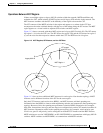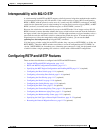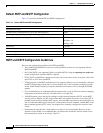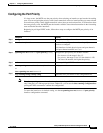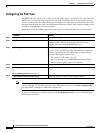
11-11
Catalyst 2950 Desktop Switch Software Configuration Guide
78-11380-05
Chapter 11 Configuring RSTP and MSTP
Interoperability with 802.1D STP
Interoperability with 802.1D STP
A switch running both MSTP and RSTP supports a built-in protocol migration mechanism that enables
it to interoperate with legacy 802.1D switches. If this switch receives a legacy 802.1D configuration
BPDU (a BPDU with the protocol version set to 0), it sends only 802.1D BPDUs on that port. An MST
switch can also detect that a port is at the boundary of a region when it receives a legacy BPDU, an MST
BPDU (version 3) associated with a different region, or an RST BPDU (version 2).
However, the switch does not automatically revert to the MSTP mode if it no longer receives 802.1D
BPDUs because it cannot determine whether the legacy switch has been removed from the link unless
the legacy switch is the designated switch. Also, a switch might continue to assign a boundary role to a
port when the switch to which this switch is connected has joined the region. To restart the protocol
migration process (force the renegotiation with neighboring switches), you can use the clear
spanning-tree detected-protocols privileged EXEC command.
If all the legacy switches on the link are RSTP switches, they can process MSTP BPDUs as if they are
RSTP BPDUs. Therefore, MSTP switches send either a version 0 configuration and TCN BPDUs or
version 3 MSTP BPDUs on a boundary port. A boundary port connects to a LAN, the designated switch
of which is either a single spanning-tree switch or a switch with a different MST configuration.
Configuring RSTP and MSTP Features
These sections describe how to configure basic RSTP and MSTP features:
• Default RSTP and MSTP Configuration, page 11-12
• RSTP and MSTP Configuration Guidelines, page 11-12
• Specifying the MST Region Configuration and Enabling MSTP, page 11-13 (required)
• Configuring the Root Switch, page 11-14 (optional)
• Configuring a Secondary Root Switch, page 11-16 (optional)
• Configuring the Port Priority, page 11-17 (optional)
• Configuring the Path Cost, page 11-18 (optional)
• Configuring the Switch Priority, page 11-19 (optional)
• Configuring the Hello Time, page 11-19 (optional)
• Configuring the Forwarding-Delay Time, page 11-20 (optional)
• Configuring the Maximum-Aging Time, page 11-21 (optional)
• Configuring the Maximum-Hop Count, page 11-21 (optional)
• Specifying the Link Type to Ensure Rapid Transitions, page 11-22 (optional)
• Restarting the Protocol Migration Process, page 11-22 (optional)









